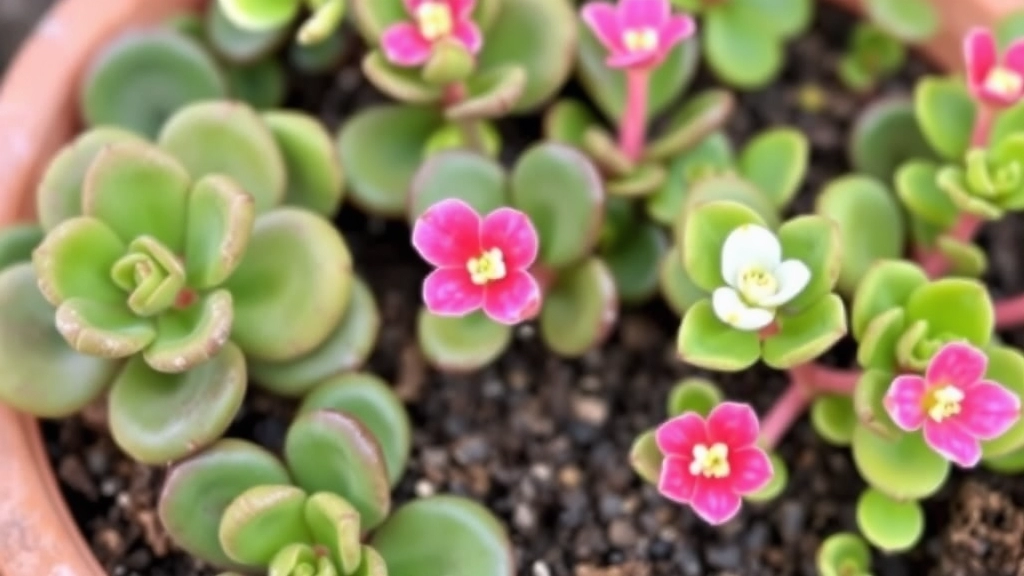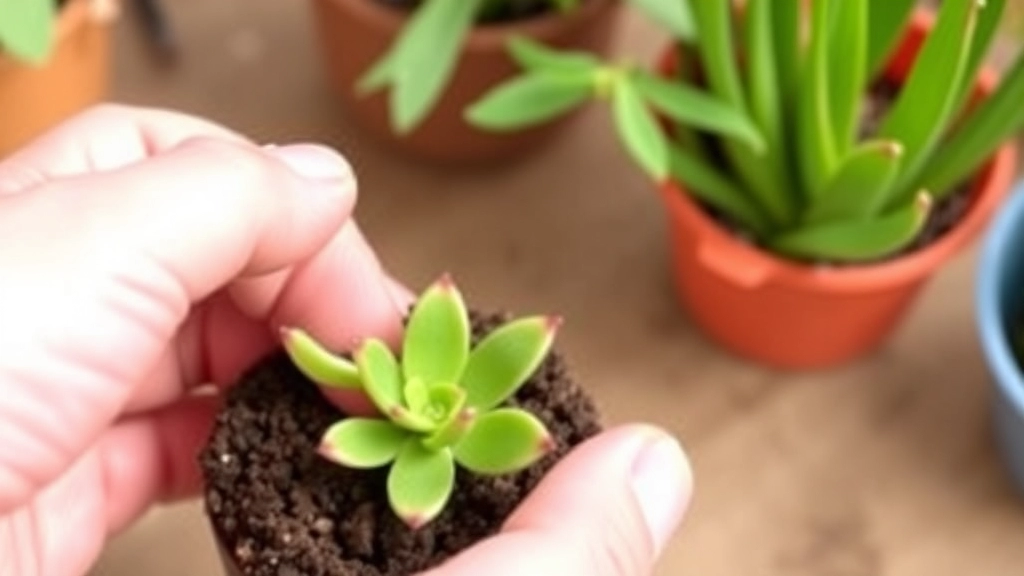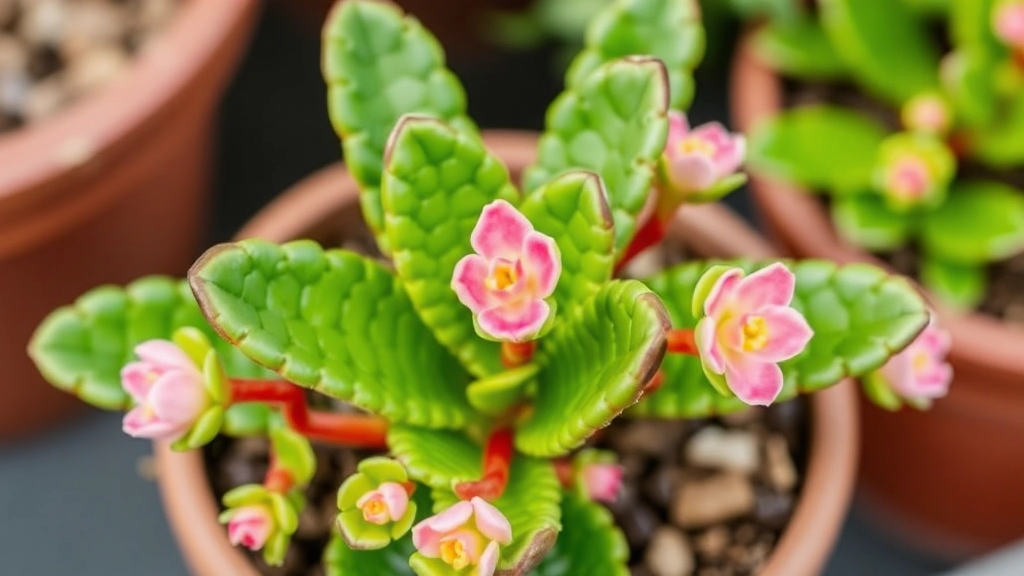Growing a Kalanchoe Paddle Plant
If you’re looking to grow a Kalanchoe Paddle Plant, you’ve come to the right place. These unique succulents thrive under the right conditions, and I’m here to share the essentials. Let’s dive into the optimal growing conditions, watering and soil requirements, and light and temperature needs for your paddle plant.
Whether you’re a beginner or an experienced gardener, understanding propagation techniques and common problems will help you keep your Kalanchoe Paddle Plant healthy. I’ll also cover the best practices for both indoor and outdoor cultivation, ensuring your plant flourishes year-round.
Optimal Growing Conditions for Paddle Plants
Are you struggling to keep your Kalanchoe paddle plants thriving?
Understanding the optimal growing conditions is crucial for ensuring their health and vibrancy.
Paddle plants, known for their striking appearance and resilience, flourish best in specific environments.
Ideal Environment
- Temperature:
- Aim for a temperature range of 20-25°C (68-77°F) during the day.
- Nighttime temperatures can drop slightly, but avoid anything below 10°C (50°F).
- Humidity:
- These plants prefer low humidity levels.
- Ideally, keep humidity below 50% to prevent rot.
- Air Circulation:
- Good air circulation is vital.
- Ensure your paddle plants are not overcrowded to allow for proper airflow.
Soil Composition
- Use a well-draining potting mix, ideally a cactus or succulent blend.
- Adding perlite or sand can enhance drainage.
Location
- Choose a spot that provides stability and protection from harsh elements.
- Indoor plants benefit from being placed near a south-facing window.
For more detailed guidance on maintaining healthy paddle plants, check out our Kalanchoe Paddle Plant Flower Care Guide. Additionally, if you’re curious about other species, our Comprehensive Kalanchoe Species List for Gardeners provides extensive information.
Watering and Soil Requirements for Kalanchoe Paddle Plants

So, you’ve got your Kalanchoe paddle plant, and now you’re wondering about the best way to keep it thriving.
Watering Tips:
- Let It Dry Out: Paddle plants prefer to dry out between waterings. Stick your finger in the soil; if it feels dry an inch down, it’s time to water.
- Frequency Matters: Generally, every 2-3 weeks during the growing season is ideal. In winter, cut back to once a month.
- Watering Technique: Water deeply but infrequently. Ensure excess water drains away to prevent root rot.
Soil Requirements:
- Well-Draining Soil: Use a cactus or succulent mix for optimal drainage. You can also mix regular potting soil with sand or perlite.
- pH Level: Aim for a slightly acidic to neutral pH (around 6.0 to 7.0). This helps your paddle plant absorb nutrients effectively.
- Repotting: Every couple of years, consider repotting to refresh the soil. This gives the roots more room to grow and access fresh nutrients.
When it comes to nurturing Paddle Plants, understanding their light and temperature requirements is crucial for their growth and overall health. Many plant enthusiasts often wonder, “How much light does my Paddle Plant need?” or “What temperature is ideal for my Kalanchoe?”
### Light Requirements
Paddle Plants thrive in bright, indirect sunlight. Here are some key points to consider:
– **Direct Sunlight**: While they can tolerate some direct sunlight, too much can scorch their leaves.
– **Ideal Location**: A south-facing window is often the best spot, providing ample light without the harsh afternoon rays.
– **Signs of Insufficient Light**: If your plant’s leaves become elongated or pale, it may be a sign that it needs more light.
### Temperature Needs
Temperature plays a significant role in the health of your Paddle Plant. Here’s what you should keep in mind:
– **Optimal Range**: These plants prefer temperatures between 20°C to 30°C (68°F to 86°F).
– **Avoid Extremes**: Keep them away from cold drafts or sudden temperature changes, as they are sensitive to cold.
– **Winter Care**: During the colder months, ensure they are kept in a warmer environment, ideally above 10°C (50°F).
For more detailed care tips, you might find our [Kalanchoe Paddle Plant Care Guide](https://planthq.org/kalanchoe-paddle-plant-care-guide-tips-for-thriving-growth/) helpful. Additionally, if you’re interested in exploring other varieties, check out our guide on [Top Flowering Kalanchoe Species and Care Tips](https://planthq.org/top-flowering-kalanchoe-species-and-care-tips/).
Propagation Techniques for Paddle Plants

After ensuring your Paddle Plants are thriving, you might wonder how to expand your collection or share these beautiful succulents with friends. Propagation is a rewarding process that allows you to grow new plants from existing ones.
Methods of Propagation
- Leaf Cuttings
- Select a healthy leaf from the parent plant.
- Allow the cut end to dry for a few days until a callous forms.
- Place the leaf on well-draining soil, ensuring it’s slightly buried.
- Water sparingly until roots develop.
- Offsets
- Look for small offsets or “pups” at the base of the plant.
- Gently twist or cut the offset away from the parent plant.
- Let it dry for a day to form a callous.
- Plant in a suitable potting mix and water lightly.
- Stem Cuttings
- Cut a healthy stem just below a node.
- Allow the cut end to dry for a few days.
- Plant in a well-draining soil mix.
- Water sparingly until roots form.
Tips for Successful Propagation
- Timing: Spring and early summer are the best times for propagation, as the plant is actively growing.
- Environment: Keep the cuttings in a warm, bright location but out of direct sunlight to prevent scorching.
- Humidity: A humidity dome or plastic bag can help retain moisture, but ensure proper ventilation to avoid rot.
Propagation not only enhances your gardening skills but also fosters a deeper connection with your Paddle Plants.
Common Problems and Care Tips for Healthy Growth
As we delve into the common problems faced by Kalanchoe paddle plants, it’s essential to understand that proactive care can prevent many issues.
Best Practices for Indoor and Outdoor Cultivation
So, you’re ready to dive into the world of paddle plants, huh? Whether you’re keeping them indoors or letting them bask in the sun outside, there are some golden rules to follow for optimal growth.
FAQs on Kalanchoe Paddle Plants
How often should I water my Kalanchoe Paddle Plant?
Generally, you should water your Kalanchoe Paddle Plant every 2-3 weeks during the growing season. In winter, reduce the frequency to once a month. Always let the soil dry out between waterings.
What type of soil is best for Kalanchoe Paddle Plants?
Kalanchoe Paddle Plants thrive in well-draining soil. A cactus or succulent mix is ideal, but you can also mix regular potting soil with sand or perlite to improve drainage.
What pH level is suitable for Kalanchoe Paddle Plants?
A slightly acidic to neutral pH level, around 6.0 to 7.0, is best for Kalanchoe Paddle Plants. This helps the plant absorb nutrients effectively.
How do I propagate my Kalanchoe Paddle Plant?
There are several methods to propagate your Kalanchoe Paddle Plant, including leaf cuttings, offsets, and stem cuttings. Each method involves allowing the cut ends to dry and form a callous before planting in well-draining soil.
When is the best time to propagate Kalanchoe Paddle Plants?
The best time for propagation is during spring and early summer when the plant is actively growing. This increases the chances of successful root development.
What environment is best for propagating Kalanchoe Paddle Plants?
Keep the cuttings in a warm, bright location but out of direct sunlight to prevent scorching. Using a humidity dome or plastic bag can help retain moisture, but ensure proper ventilation to avoid rot.
How do I know when to repot my Kalanchoe Paddle Plant?
Consider repotting your Kalanchoe Paddle Plant every couple of years. This refreshes the soil, giving the roots more room to grow and access to fresh nutrients.
References
-
Kalanchoe Paddle Plant Care: How to Grow & Maintain
-
Gardening Know How: Kalanchoe Paddle Plant Care
-
World of Succulents: Kalanchoe thyrsiflora (Paddle Plant)
